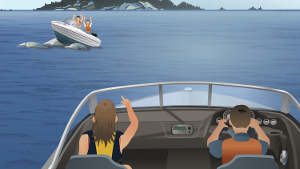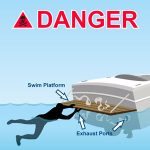Estimating Distances to Horizontal Objects – To make a quick estimate of distance, extend your arm straight out in the direction of the object, and stick your thumb up. Close one eye and line up one side of your thumb with the object (another boat or a building, for example). Now switch eyes quickly and observe how far your thumb appears to “jump” in relation to the object. You will have to estimate the length of the object. (For example, you may guess that a pontoon boat is 24 feet in length.) Let’s say that your thumb appear to jump three times the length of the pontoon boat, or roughly 75 feet. Now multiply 75 feet by 10, and you will find that the pontoon boat is roughly 750 away from you.
Estimating the Position of a Center of Atmospheric Low Pressure (unstable air, stormy) – Stand with your face into the wind, and extend your right arm out to your right side, just beyond 90 degrees. Your hand will be pointing in the general direction of the center of a low pressure area. Why useful? Let’s say you’re out on a body of water and it begins to look or feel like the weather may be changing. Using this method, you determine the approximate location of the low pressure area. If that direction seems to be north of you, and storms at that time of year in your area generally move from southwest to northeast, the low will probably not affect you adversely. However, if you find yourself pointing southwest with this method, you may wish to further assess your plans in light of the fact that you are probably in the path of approaching instability in the atmosphere (storm). This method is called Buys Ballot’s Law, and has been used by mariners for centuries to assess changes in weather. Remember, it is only one aid in your arsenal of decision-making tools.
Judging the Risk of Collision – “Relative Bearing” is the term used to describe the angle between your boat and another boat or object. For example, the relative bearing of a boat directly in front of your boat is 0 degrees, directly behind you, 180 degrees, and so on. To use relative bearings to determine your risk of collision with another boat, the actual bearing in degrees is not needed. All you need to know is whether the bearing of the other boat, in relation to yours, is changing or staying the same as you move through the water over time. To determine this, start by “sighting” the other vessel over a fixed object on your own boat, such as the end of the windshield or a cleat. Then, without moving your head, check from time to time to see if the other vessel is still sighted in that same place, using the same position of your eyesight and the sighting object on your boat as before. If the other vessel is still in the same exact position relative to your boat, you are on a collision course. If the other vessel has moved “forward” from your sight position, the other vessel will ultimately cross in front of you. If the other vessel has moved “backward” from your sight position, you will ultimately cross in front of them.
Judging Approximate Distances to Shorelines – On the water, the distance to the horizon in statute miles is about 1.33 times the square root of your height above the water. In most runabouts, your position in the helm is about 4 feet above the water’s surface. The square root of 4 is 2, so you multiply 2 times 1.33, and you get 2.66. So, when you first see the waves lapping at the white sandy beach where you’ll be having lunch, you’ll have a bit less than 3 miles to go before chowing down. If you’re standing on the flybridge of a cruiser, and you’re about 16 feet off the water, you’d use the square root of 16, or 4 foot, times 1.33, to find that you’re a little over five miles from the shore.








